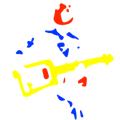The chord finder helps you find chords for your 3 string guitar, tuned GDG, based on 3 different criteria. You can choose the letter name of the chord, more correctly known as the root of the chord. You can choose a chord quality such as major, or minor. You can also choose a chord position. All of these will be important considerations in your final choice but none of them should override the most important factor which is what it sounds like to you.
Chord Structure
A chord contains at least 3 notes, the 1st, 3rd and 5th notes of the associated scale. In the diagrams I've coloured the dots according to which of these notes they are. Some chords add an extra note (some add lots of extra notes), the ones listed here add either the flattened 7 note to make a 7th chord or the 6th note to make a sixth chord. When you get more into the theory that will all make more sense but just know for now that not all chords are created equally and it's because of which of these notes are selected.
Chord Voicings
The Voicing refers to that particular combination of notes that you choose to play the chord. You'll notice in the charts that some chords will be missing a red dot, others missing a yellow dot, these choices all have consequences for the sound of the chord so listen closely to see which of these combinations you prefer. A general rule would be the more different coloured dots, the better.
Chord Positions
So you found all the chords with the most different coloured dots but don't restrict yourself to those. An important consideration when changing chords is to stay as close as possible to the previous one. You generally want to avoid jumping from one end of the neck to another. Sometimes you'll pick a voicing that doesn't sound so great by itself but it connects up with other chords a whole lot better and it's the overall sound that matters
